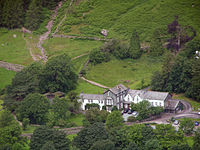Great Langdale

Great Langdale is a beauteous valley in the Lake District; the name 'Great' distinguishes it from the neighbouring dale, Little Langdale. Great Langdale is in the west of Westmorland: the mountains around the head of the dale stretch up to the boundary of Cumberland, and the dale descends eventually to the northernmost bounds of Lancashire, at Skelwith Bridge.
The dale is watered by the Langdale Beck, and in its last miles, below Elter Water, by the River Brathay, which marks the Lancashire border.
Langdale is a popular location for hikers, climbers, fell-runners and other outdoor enthusiasts who are attracted by the many fells ringing the head of the valley. One of the best known features of Great Langdale are the Langdale Pikes, a group of peaks on the northern side of the dale. The highest mountain of the Lake District, Scafell Pike in Cumberland, can be climbed by a route from Langdale.
Langdale has spectacular views of, in particular, Dungeon Ghyll Force waterfall, Harrison Stickle and the Pike of Stickle.
Langdale was an important site during the Neolithic period for producing stone axes, and the 'Langdale axe industry' is much studied. In more modern times the dale was one of the centres of the Lakeland slate industry.
Geography
The mouth of the valley is located at Skelwith Bridge, which lies about two miles west of the town of Ambleside. The Langdale valley contains two villages, Chapel Stile and Elterwater, and a hamlet at High Close. It is a U-shaped valley formed by glaciers, while Little Langdale is a hanging valley.
History
Axe industry
In the Neolithic period, the New Stone Age, Langdale was a centre for tool-making and this concentrated production here is known to archaeologists as the Langdale axe industry. Langdale is known to archaeologists as the source of a particular type of Neolithic polished stone axe head, created on the slopes of the Pike of Stickle and traded all over prehistoric Great Britain and Europe. These axes were fashioned from the outcrops of fine-grained greenstone found on th fells here.[1] The rock is an epidotised greenstone quarried or perhaps just collected from the scree slopes in the Langdale Valley on Harrison Stickle and Pike of Stickle.
Neolithic cup and ring marks are found on the Langdale Boulders at Copt Howe.
Langdale also supplied stone for some Bronze Age items, such as stone wrist-guards.
Slate industry
Langdale and Elterwater were centres of the Lakeland slate industry. Two slate workings, Elterwater Quarry and Spout Cragg Quarry, have been more or less continually working using modern methods. Elterwater is the larger of the two, and like Spout Cragg, is operated by the Burlington Stone company. There are various other local quarries now fallen into disuse, such as Lingmoor, Banks, Thrang Crag and Colt Howe.
The Langdale Pikes

One of the best known features of Great Langdale are the Langdale Pikes, a group of peaks on the northern side of the dale. From below, they appear as a sharp rocky ridge, though they are only precipitous on their southern side; to the north, the land sweeps gently to High Raise, the parent peak of the range. The Pikes themselves include (from west to east) Pike of Stickle, Loft Crag, Harrison Stickle and Pavey Ark.
Other fells

Langdale's highest fell is Bow Fell. Other notable Langdale fells are Crinkle Crags, at the head of the Oxendale valley, and Pike o' Blisco on the southern side of the valley.
Dungeon Ghyll
Dungeon Ghyll is a ravine on the north side of the valley. It starts on the fell slopes between Harrison Stickle and Loft Crag/Pike o' Stickle. It is narrow, and a No Through Route for walkers. Much more open is Stickle Ghyll, which descends from Stickle Tarn. There is a well–trodden path from the Stickle Ghyll car park at Old Dungeon Ghyll up to the tarn, parts of which have been improved with stone slabs to reduce erosion. The waterfall is known as Dungeon Ghyll Force.
Tourism

There are a number of popular fell walking routes include Bowfell, Crinkle Crags, the Langdale Pikes and the region's highest mountain, Scafell Pike. There are also rock climbing spots on the valley floor, such as Raven Crag, Gimmer Crag and White Ghyll, providing some of the most spectacular rock routes in Britain.
The Langdale Leisure Limited company, consisting of a hotel, timeshare lodges and leisure facilities, operates in the valley.
Old Dungeon Ghyll
The Old Dungeon Ghyll Hotel was originally a farm and inn. It was bought by the historian Professor G.M. Trevelyan who donated it to the National Trust. The hotel and the Hikers Bar have a long association with climbing and many famous climbers have stayed at the hotel or drunk in the bar. In climbing circles it is known as the "ODG".[2] Further down the valley there is the New Dungeon Ghyll hotel, built in 1862.[3] Campsites in the area include the National Trust site near Dungeon Ghyll and the Baysbrown Farm campsite at Chapel Stile.
Outside links
| ("Wikimedia Commons" has material about Great Langdale) |
- Location map: 54°26’57"N, 3°4’24"W
- Streetmap: NY305065
References
- ↑ Rodney Castleden, Neolithic Britain: new stone age sites of England, Scotland, and Wales. Routledge, 1992. ISBN 0415058457. http://books.google.com/books?id=-wYOAAAAQAAJ&pg=PA60&dq=Langdale+axe+industry&as_brr=3&ei=8brQSqKrMor-zQSsxL2CDg&client=firefox-a#v=onepage&q=Langdale%20axe%20industry&f=false. Retrieved 2009-10-10.
- ↑ "The Old Dungeon Ghyll Hotel in Langdale has a fascinating history in the Lake District area". www.odg.co.uk. http://www.odg.co.uk/about/index.cfm?id=2. Retrieved 2009-10-10.
- ↑ Bill Birkett (15 November 2004). A Year in the Life of the Langdale Valley. Frances Lincoln Ltd. pp. 13. ISBN 978-0-7112-2449-0. http://books.google.com/books?id=ijL8S7NX6bYC&pg=PT13. Retrieved 8 February 2012.
